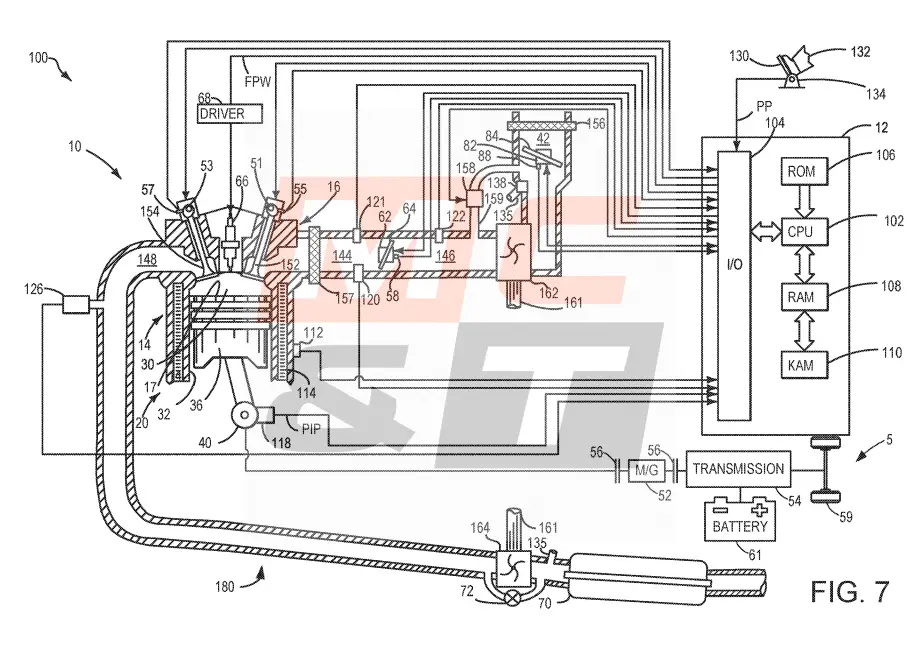
The company announced demand-driven production bumps for its two BEVs, the Mustang Mach-E and the incoming F-150 Lightning pickup truck. Plans for two battery factories in Kentucky and one in Tennessee were detailed, alongside a BEV mega campus in Tennessee. Even more significant, the company plans an internal restructuring separating the internal combustion and electric vehicle programs into respective silos. Amidst all the high-profile BEV news, Ford engineers have been quietly exploring ways to keep the internal combustion side of the business healthy, including a new method of hydrogen combustion.
Discovered by MC&T within the U.S Patent and Trademark Office database, Ford has created a method of combustion allowing a turbocharged hydrogen-fueled engine to operate across a wide range of air/fuel lambda values depending on torque demands. Internal exhaust gas recirculation (EGR) and valve timing would be used to control combustion.
Lambda is the Greek letter used to represent a fuel’s stoichiometric value as 1.00. The stoichiometric value of a fuel is the ratio by which all of the fuel is combined with all of the oxygen to produce a complete burn. Gasoline engines have a stoichiometric value of 14.7:1, meaning 14.7 parts of air to 1 part gasoline equals a lambda of 1. Lean combustion is represented as a value higher than 1.00, while richer mixtures are shown as less than 1.00.
For the most part, a gasoline engine can operate in a range from 8:1 at the richest to 18.5:1 at the lean end of the spectrum. Lambda is calculated by diving the air/fuel ratio into the stoichiometric value of the fuel–so the richest gasoline combustion mixture is represented as 0.54 lambda, while the leanest is 1.25 lambda. Ford’s new method of turbocharged hydrogen combustion looks to explore lambda values in excess of 2.00. Meaning the engine would be capable of operating in an extremely lean state, using more than double the amount of air required for the stoichiometric combustion of hydrogen.

Available data indicates hydrogen’s stoichiometric value is in the 34:1 range, so if Ford is running hydrogen combustion at a Lambda of 2.00 or beyond that means the engine has an air/fuel mix of at least 68 parts air to 1 part hydrogen. For what it’s worth, Mike Copeland’s hydrogen converted LS engines are running at 100:1 with the help of a supercharger. Hydrogen is capable of combusting at such lean air/fuel mixtures because of the fuel’s low impedance to ignition. At stoichiometric values hydrogen has an extremely fast flame speed, it’s described as roughly an order of magnitude faster than gasoline. The increased flame speed means there is a much greater chance of detonation, however, if the mixture is leaner, the flame speed is reduced.
For Ford’s method of hydrogen combustion to work the hydrogen would be introduced via direct injection, allowing fuel and air to be controlled independently of one another compared to using port injection, which mixes the air/fuel upstream of the combustion chamber. Supplied using DI, hydrogen is capable of providing 15% more power than gasoline.
Using a constant fuel input, the amount of EGR can be altered to move the post-combustion lambda value from 1.00 all the way to 2.00 or above. Under higher torque demands when the mixture is richer in hydrogen, EGR flow would be increased to reduce the temperature within the combustion chamber, thus reducing the chance of pre-ignition. This is true because the recirculated exhaust gas enrichens the hydrogen mixture by displacing the air that would normally be present in the chamber. Remember, a combustion engine creates maximum power from a slightly rich air/fuel mixture, while a leaner mixture is better for fuel economy. A lean mix fundamentally contains less fuel than a richer one. When torque demands are lower and the hydrogen engine is running leaner, less EGR would be provided.

